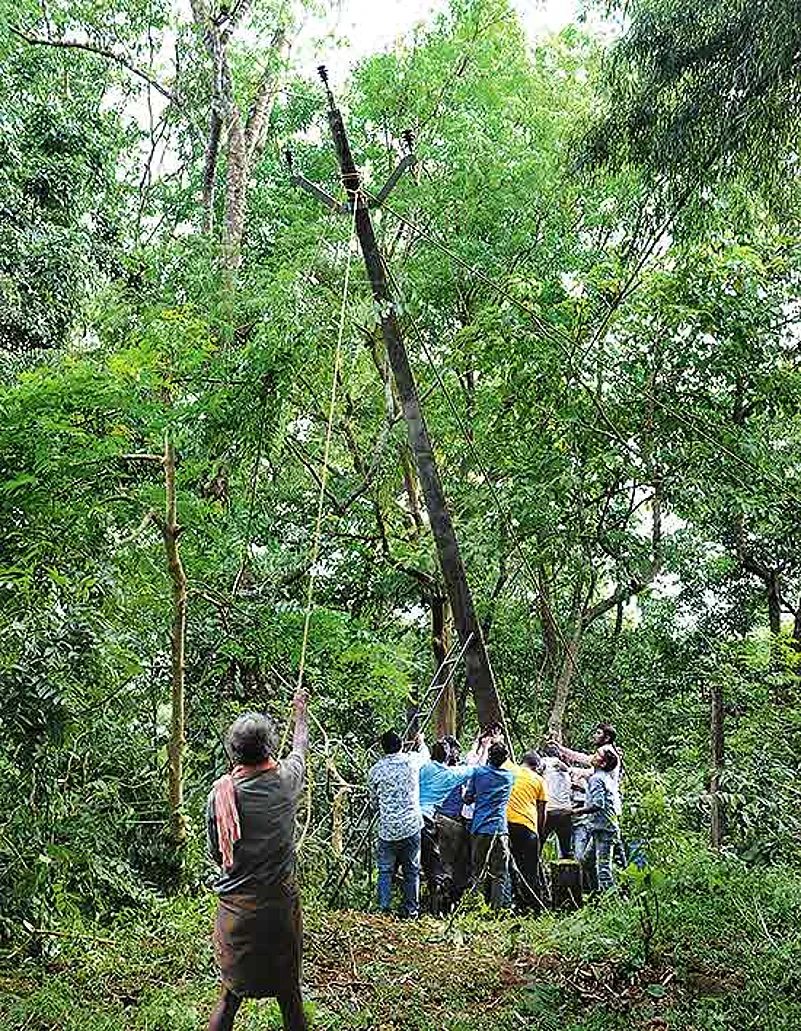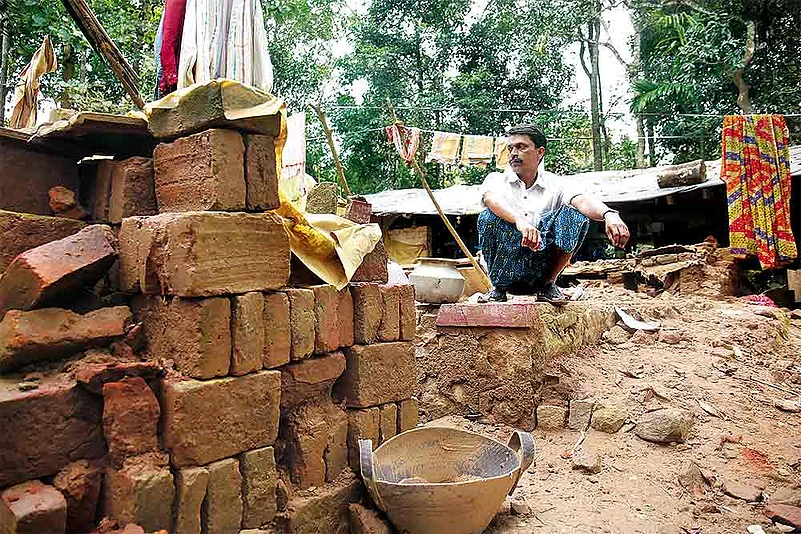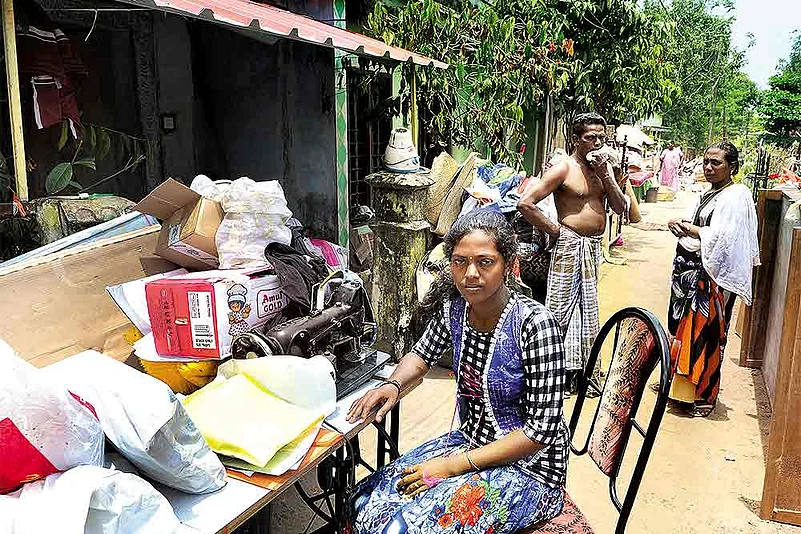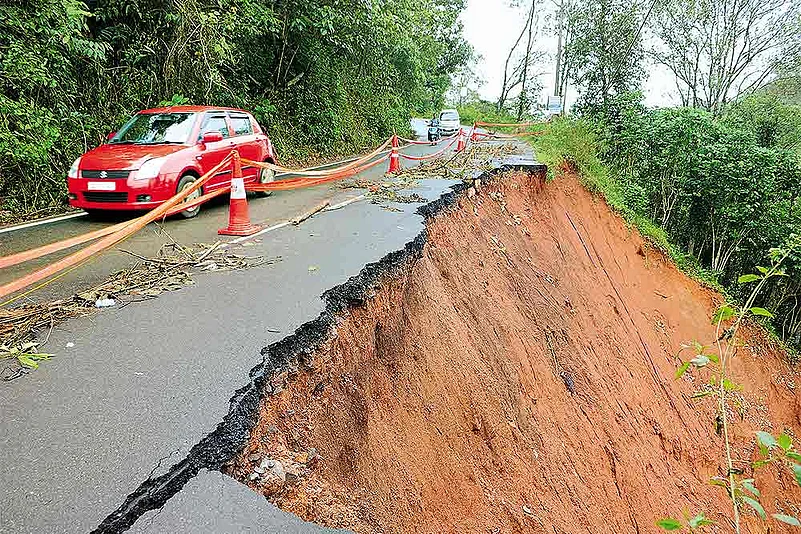In Raw Numbers
- Lives Lost 400
- Roads Damaged 80,000 km
- Houses Destroyed 26,000
- Livestock Lost 2,46,000
- Crops Ruined 40,000 ha
***
The night of August 15 was menacingly dark, recalls Rosie Thelakkat, 73, with a painful shudder. As the torrential rains bore down, the floodwaters swiftly devoured everything in their path. The deafening roar of the rushing waters was broken by the terrified cries of animals for miles around the farmlands of Thykoodam Kadakootti, Chalakudy. Only later would Rosie learn that their two cows had survived the flood by standing on their hind legs, holding onto the barn’s wall for a whole night and day, with their noses stretched above the water, while their calves drowned beside them.
Unable to escape in time, Rosie, her two sons and their spouses had huddled under a sunshade on the roof of her home, watching helplessly as her elder son’s house was swiftly submerged under the waters. “We spent a sleepless night watching the dark swirling waters stealthily inching towards us. We just waited, knowing well that there was no escape. It was only by the next afternoon that the fishermen came to rescue us,” says Rosie, her eyes welling up. “The flood took away everything that we had. There’s nothing that has not been destroyed.”
Read Also: Grow With Roots In The Earth
Like lakhs of others affected by the great flood of Kerala, Rosie’s family are cleaning their home of the tonnes of slushy silt that the receding waters left in their wake. The stench of alluvium and waste, an ancient beast regurgitated by the Chalakudy river, is hard to shake off even after the sun has come out. There’s no one in Chalakudy market (on a higher gradient than Thykoodam) who has not felt the crippling loss of goods and life savings. They rush towards us, hands folded, urging us to visit their shops, hoping that we are efficient government officials come to survey and quickly enumerate their loss and pain. How will we recover the loss, how will we rebuild our lives…these are questions on many a lip.

Bringing power back to Thumburmoozhi, Chalakudy
The water had rushed in far too quickly to save anything. “Before we knew it, the road had turned into a river and we had to wade chest deep in water to save ourselves. In a matter of minutes, the floodwaters were entering our shops and washing away our goods,” says V.J. Paulson, who has a grocery shop in the market. “We did not know the waters would rise over six feet.”
By the end of July, all six major dams on the upper reaches of the Chalakudy river were nearing full capacity, and the unrelenting monsoon rains had many people worried, especially S.P. Ravi of Chalakudyaar Samrakshana Samithi. In the middle of July, Chalakudy had already witnessed some low-level flooding and the waters had yet to recede, so Ravi and his colleagues had urged the district administration to action. “We tried to convince the administration that the water levels could rise further by one to two metres over the previous flooding in case of very heavy rains. We urged them to release the waters of the dam in a controlled manner and take all possible steps to do a flood line mapping and start evacuation to mitigate the disaster,” Ravi tells Outlook.

On the morning of August 15, Ajithkumar saw water gushing down the street and into their house at great speed. The family didn’t even have time to put away their things on the terrace. They immediately piled into their car and fled the place, abandoning everything. Their car was the last to leave when the water was still at a driveable level. The cars that did not leave got submerged. “Around 2 pm, I came back to check on the house but it was submerged up to the sunshade. All our clothes, our documents...everything we have is lost. It’s very unlikely that we will be able to salvage anything of value. We will have to wash our vessels many times over before we can use them. We have to start right from the beginning and buy everything from salt to camphor.”
Just as Ravi and his colleagues had warned, the already full reservoirs had to open all their shutters by August 15. The next day, the water released by the five upper dams was of such humongous volumes, speeding into the relatively smaller capacity 424-metre Poringalkuthu dam, that it jumped 2.5 metres over the dam and rushed towards Chalakudy. It was a disaster in the making.
Poringalkuthu dam was overflowing with no control. Huge trees that were uprooted on the way to Poringalkuthu were lodged against the dam, and large amounts of mud and stone on one side of the dam were washed away. If the structure had not withstood the flood wave that was cascading down, Chalakudy and the surrounding towns would have been washed away into the Arabian Sea.
“An overflowing dam speaks volumes about the ineffectiveness of dam operations. It showed there was no control over the dam waters during heavy rainfall. What was more alarming was that communication was completely knocked out in the dam area. It’s strange that these places of strategic importance did not have wireless sets in case communication of one particular mode failed. If we are looking to rebuild a new Kerala, climate change must be factored in, for it is a reality. Kerala has oscillated between extreme climates of drought and floods in the last two years. It is essential that flood mapping is carried out—it does not exist now even in a crude form,” says Ravi.

When water reached Jayadevan’s house after the opening of the Banasura Sagar dam, he fled with his family, including an autistic 11-year-old daughter, taking only their Aadhaar and ration cards. The house was washed away, and they moved to his wife’s house. “I had stopped going for work as I am the one who takes care of my daughter. My wife is an anganwadi teacher and that’s our only income. I don’t want to bother my wife’s family either. I just want a makeshift bed here. I have to be with my daughter constantly because I may have to take her to the hospital at any time,” says Jayadevan. “I have to rebuild my life. But I don’t know what to do now,” he adds, waiting for state aid to build a house.
Almost every district of Kerala, barring Kasaragod, was affected by the flooding of the state’s 44 rivers and countless tributaries. Kerala has 61 major dams and nearly as many smaller dams for irrigation. Though the government claims that dams prevent flooding of the rivers, this year, the continuous rains filled all the dams to capacity, and the simultaneous opening of their shutters only compounded the problems. In addition, at least three major rivers changed course and surprised towns that were least expecting it.
According to the 2017 CAG report on Schemes for Flood Control and Flood Forecasting, Kerala had not prepared emergency action plans for any of its dams to mitigate the disaster in the eventuality of a dam break. The effect of such high levels of water can be mitigated to a great extent if the magnitude of flood peak and its time of arrival at different locations downstream of the dam can be estimated, thereby facilitating the planning of emergency action measures. Though there was a warning for those living upstream of the Periyar river, when Idukki dam was opened for the first time in 26 years, those living downstream near the mouth of the river in towns like Aluva and Ernakulam were not adequately prepared for flooding of such magnitude.
Embarrassingly for Kerala, the Cochin International Airport (CIAL) in Nedumbassery, Aluva, had to be closed down for several weeks because of flooding. The airport was constructed on the floodplains of the Periyar, and the runway sits on one of the tributaries, Chengalthodu. The creek was diverted around the airport, and solar panels were put across the creek, further blocking the flow of the water. Some allege that CIAL refused to consider their requests to remove the solar panels.

Since the Eid, Onam and Sabarimala seasons were around the corner, Shamshuddin had stocked up high on clothes worth over Rs 25 lakh, for which he had borrowed money from the banks. He had bought saris, kavi dhotis for men and fancy dresses for girls. “I am from Cumbum, Tamil Nadu, but 10 years ago I made this place my home. I’ve lost everything in my shop and my home all in one go. Everything is muddied with slush and dirt. Even if I wash these clothes many times over, they will never become clean. I will finally burn them.”
The high airport walls block the natural flow of the creek, and that caused a lot of flooding in the surrounding areas. “From the time the shutters were opened on August 10, the adjoining areas that lie in the limits of four panchayats were affected by the flooding—Kanjoor, Nedumbasserry, Sreemoolanagaram and Chengamanad,” says V.V. Sebastian, ward member of Sreemoolanagaram panchayat. Environmentalist John Peruvanthanam says the social cost of the damages should be borne by CIAL. “Unless they are held accountable, they will continue to damage the environment, and poor people will continue to suffer.”
The heavy rains and the opening of the dams gave life to the Periyar river and, in its full form and might, it vented its fury and reclaimed its natural course, sweeping away all encroachments on the river beds and floodplains. Even the airport, a symbol of modernity, could not withstand the force of Chengalthodu, otherwise a small creek. The floodwaters broke down the wall on one side, ran across the airport and crashed down the opposite wall.
Sreemoolanagaram panchayat secretary Meena S.G. says they had made preparations in case of flooding for around 250 people in three relief camps, but 16 government camps and numerous impromptu camps had to be opened to house the evacuated because of the sheer degree of flooding. “Almost 90 per cent of the people were rescued by people I call guardian angels, who came from nowhere on boats. And we did not have food shortages for even a single day. It was only much later that government and outside help came, as we were isolated from the rest of the world,” says Meena.
The consequences of tampering with nature were also felt in the case of Mangalthodu, a creek in Aluva. Its waters were regulated through a pipeline, but that bit of engineering fell woefully short when the road constructed over the pipes was swept away by the flooding waters.
Rajan Chedambath, director, Centre for Heritage, Environment and Development, points out that Kerala should be willing to give up roads and buildings to protect its environment. “These floods are a big lesson for us and we should take the opportunity. To go back to our cultural and architectural heritage and use eco-friendly materials, not concretise the state. Cities like Seoul and Hamburg are showing us the way. In Seoul, they tore down a busy elevated freeway, which carried nearly 2 lakh vehicles per day, in order to restore the Cheonggyecheon river that lay buried underneath. And in Hamburg, they are greening the roads and stopping all motorised traffic through some parts. Kerala should abandon its current development drive.”

Athira’s house sits next to the Vallimachira canal, which receives all the sewage of the town. The inevitable happened: sewage water entered homes all around, making them uninhabitable. “We were the first to leave our houses and come to the relief camp and we would be the last to get back. The stench in our houses is unbearable,” says Athira. When Kerala is rebuilding, they should account for sewage and waste management, she says. “The sewage should not flow into canals that empty out into the sea,” she says.
Nearly 300 landslides and flooding in the Western Ghats across Kerala caused the shutdown of major tourism spots like Munnar, Wayanad and Thekkady. The report of the Western Ghats Ecology Expert Panel headed by ecologist Madhav Gadgil, which the Union ministry of environment and forests refused to make public, had painstakingly zoned the area in a layered manner, using ecological sensitivity as a boundary. It gives a slew of recommendations—chief among them is that no new SEZs, new dams, mines, hill stations, roads, railway lines etc…be given clearance in zones considered highly sensitive. The report says: “Dams and thermal projects that have crossed their viable life span (for dams the threshold is 30 to 50 years) to be decommissioned in a phased manner”. Kerala formed a committee to study the report and junked it because it was considered anti-development.
Politicians could look eastward towards Seoul to learn a lesson or two. Lee Myung-bak, former president of South Korea, implemented several Green Seoul projects when he was mayor, including the Cheonggyecheon river restoration project. An environmental activist has suggested that a Special Purpose Vehicle be formed to rebuild Kerala, and that it should consist of people who are committed to the job—because there should be new tools to create a new Kerala. It is argued that using government departments like the PWD to reconstruct Kerala would be disastrous and that there needs to be caution when it comes to handing control to businessmen from West Asia, even though they are offering huge sums of money for flood relief. Peruvanthanam thinks the term “rebuilding Kerala” can seem almost frightening now if the fragile ecology is not taken into consideration. Road building and construction should be completely stopped, he says. For, if rebuilding entails levelling whole hills, then Kerala will be gone forever. “The government should acquire abandoned houses and give them to people who are in need of homes, and we must seriously think of travelling by public transport. For 3.3 crore people, there are 1.2 crore vehicles on the roads already. And now panchayats, the PWD and the Kerala State Electricity Board are competing to build roads, destroying forests and rivers.”
The environmentalists may have an unlikely ally in the business community. Shaken by the huge losses, they are ready to accept the idea of a Green Kerala. Sajikumar, chairman, CII-Kerala, puts the state’s economic loss at Rs 30,000 crore. “The tourism industry in Kumarakom has been affected badly. Hotel infrastructure has been damaged. To recover the loss and get Kerala back on its feet, we would need at least Rs 50,000 crore. The government has promised loans to SMEs, and we are planning to ask if Kerala’s business can get a break from GST,” he says.
Kumarakom, on the Vembanad lake, famous for its houseboats, had to be completely evacuated due to flooding. Vembanad lake, Kerala’s largest backwater, is now one-third its former size. The large number of encroachments includes the Lulu Convention Centre, which sits on reclaimed land on Bolgatty Island. Environmentalists like M.K. Prasad had long warned of the dire consequences of reclaiming the lake, which acts as a buffer during the floods. Both paddy fields and backwaters—which now stand reclaimed for bridges, houses and resorts—would have acted as perfect buffers, absorbing the floodwaters.
P.V. Prabhakaran, a high school zoology teacher who actively encourages nature protection among students in the government school where he teaches in Kannur, points out that Kerala’s mangroves—once a vast 700 km2, now drastically reduced—would also have acted as a buffer against flooding. “Environmental protection should be a subject taught in schools,” he says.
Perhaps we need to reconfigure the way we think about the environment in every way: linguistically, culturally, architecturally, and in religion and governance too. Linguistically would be a good start. An environmental evangelist recently said that Keralites should not consider pullu (grass)—the first layer of environmental protection against landslides—worthless. Pullu crops up profusely in our derogatory terminology: Enikku pullaanu (I don’t give a damn, or he’s as worthless as grass). True, we didn’t give a damn about the environment and we paid the price. Heavily.
By Minu Ittyipe in Chalakudy, Aluva, and Chengannur with inputs from Thufail P.T. in Athirapilly and Wayanad


























